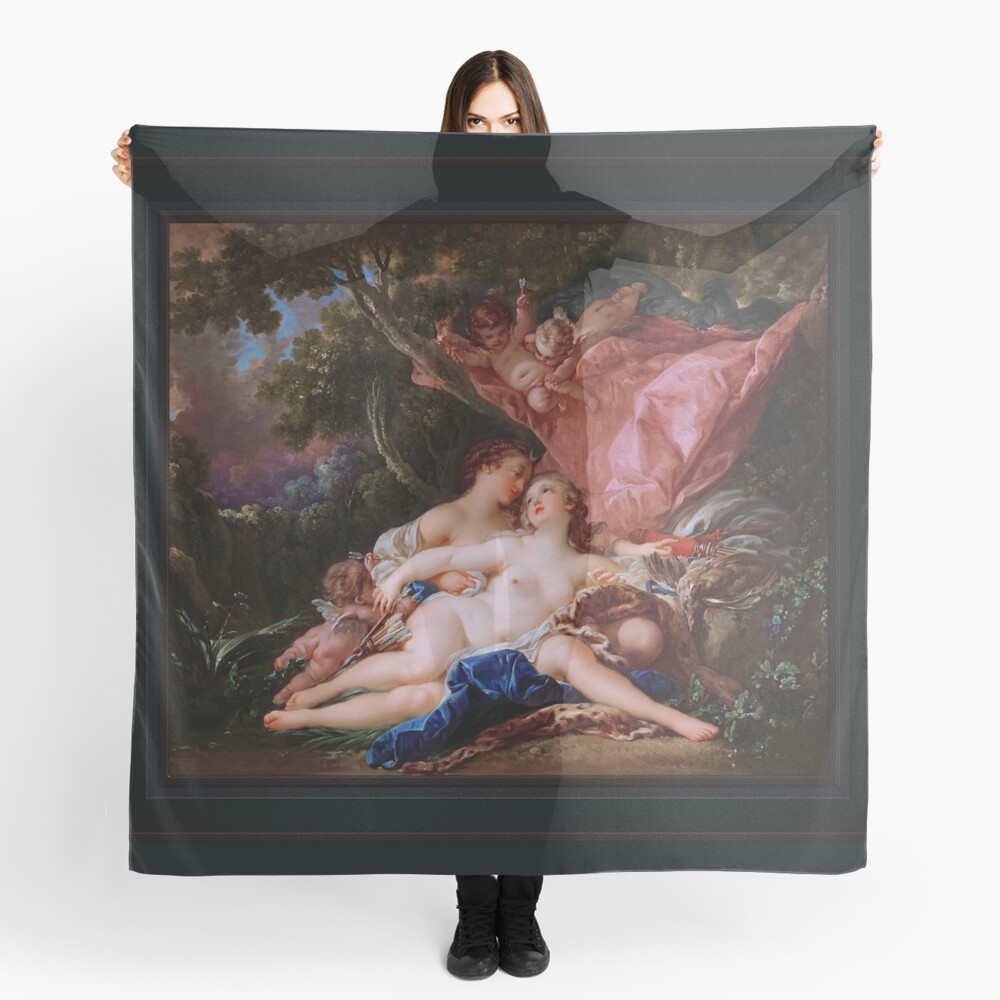
Jupiter in the Guise of Diana, and the Nymph Callisto
Jupiter in the Guise of Diana, and the Nymph Callisto c1759 by French Painter Francois Boucher (1703 – 1770); also known as a draftsman, engraver and decorator in the French Rococo style, that was well known for his lavish mythological, allegorical and erotic motifs and was the court painter of Louis XV and a favorite of the Marquise de Pompadour.

This is a beautiful scene depicting the characters from Roman mythology Jupiter (The Eagle), Diana (Goddess of the Hunt), and Callisto the favorite Nymph of Diana.
In this forest scene we can see six figures, two cherubs in a tree with a large rose drape hanging from one of its outstretched limbs, near the eagle Jupiter looking down on what appears to be Diana and her Nymph Callisto, with one holding an arrow in his left hand; with another on the ground by the pond that Diana and her Nymph Callisto are laying near with an arrow in its left hand and a quiver filled with arrows by its right side.
Jupiter, the King of the Gods taken by the beauty of Callisto, disguises himself as the huntress Diana to seduce her; embracing her while they relax by the pond on a cushion of leaves, a blue garment and leopard skin.
By the couple is a boulder that has on it a brown bird resting on the chest of light colored bird that has had its throat cut, with blood staining the rock.
Behind the birds is a red quiver filled with arrows and a bow and another wrapped up grey colored garment, that rest just under the pink drape and the eagle Jupiter.

In the background is a colorful forest of many different hues and a light blue sky filled with many colored clouds, that seems to be illuminated by a setting sun.
Jupiter in the Guise of Diana, and the Nymph Callisto is a remastered digital art old masters reproduction of a public domain image that is available as a canvas print online.
Ang Impormasyon sa Ibaba ay Nagmula Sa Wikipedia.org
A native of Paris, Si Boucher ay anak ng isang hindi kilalang pintor na si Nicolas Boucher, na nagbigay sa kanya ng kanyang unang artistikong pagsasanay. Sa edad na labing pito, isang pagpipinta ni Boucher ang hinangaan ng pintor na si François Lemoyne. Kalaunan ay hinirang ni Lemoyne si Boucher bilang kanyang apprentice, ngunit pagkatapos lamang ng tatlong buwan, pumasok siya sa trabaho para sa engraver na si Jean-François Cars.
Sa 1720, nanalo siya sa elite Grand Prix de Rome para sa pagpipinta, ngunit hindi kinuha ang kahihinatnan ng pagkakataong mag-aral sa Italya hanggang sa makalipas ang limang taon, dahil sa mga problema sa pananalapi sa Royal Academy of Painting and Sculpture.[1] Sa kanyang pagbabalik mula sa pag-aaral sa Italya siya ay ipinasok sa muling itinatag na Académie de peinture et de sculpture noong 24 Nobyembre 1731. Ang kanyang reception piece (piraso ng pagtanggap) ay ang kanyang Rinaldo at Armida ng 1734.

Ikinasal si Boucher kay Marie-Jeanne Buzeau noong 1733. Nagkaroon ng tatlong anak ang mag-asawa. Naging faculty member si Boucher sa 1734 at ang kanyang karera ay pinabilis mula sa puntong ito bilang siya ay na-promote na Propesor pagkatapos ay Rektor ng Academy, naging inspektor sa Royal Gobelins Manufactory at sa wakas ay Premier Peintre du Roi (Unang Pintor ng Hari) sa 1765. Portrait of Marie-Louise O’Murphy c. 1752
Namatay si Boucher 30 May 1770 sa kanyang katutubong Paris. Pangalan niya, kasama ng kanyang patron na si Madame de Pompadour, naging magkasingkahulugan sa istilong French Rococo, pinangungunahan ang magkapatid na Goncourt na magsulat: “Boucher is one of those men who represent the taste of a century, na nagpapahayag, personify at isama ito.”
Boucher is famous for saying that nature is “trop verte et mal éclairée” (masyadong berde at hindi maganda ang ilaw).
Si Boucher ay nauugnay sa gemstone engraver na si Jacques Guay, na tinuruan niyang gumuhit. Tinuruan din niya ang pintor ng Moravian-Austrian na si Martin Ferdinand Quadal gayundin ang neoclassical na pintor na si Jacques-Louis David sa 1767.[4] Mamaya, Gumawa si Boucher ng isang serye ng mga guhit ng mga gawa ni Guay na pagkatapos ay inukit ni Madame de Pompadour at ipinamahagi bilang isang napakagandang volume sa mga pinapaboran na courtier.



